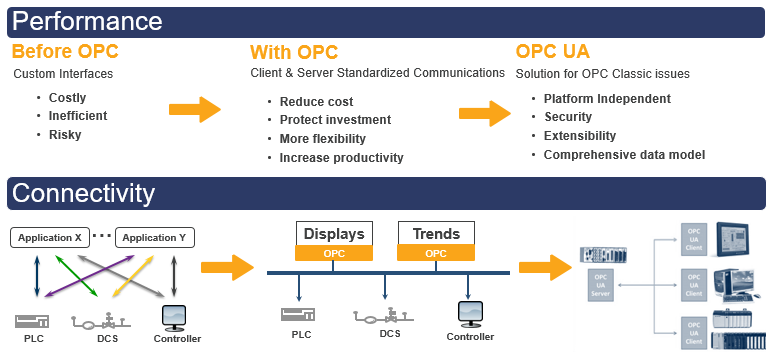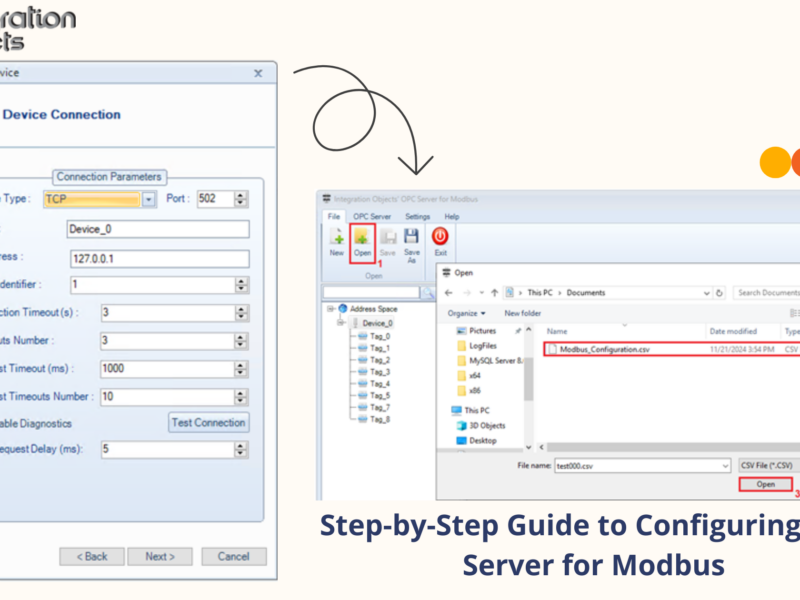What is OPC UA?
OPC UA (Open Platform Communications Unified Architecture) is a machine-to-machine communication protocol for secure, reliable, and platform-independent data exchange in industrial automation and other domains. It supports the industrial Internet of Things (IIoT) by facilitating information exchange between enterprise systems and real-world devices. OPC UA enables seamless interoperability across different manufacturers, operating systems, and communication protocols, supporting both client-server and publisher-subscriber models for diverse industrial applications designed to facilitate secure, reliable, and platform-independent data exchange in industrial automation and other domains.
· History and Development
OPC UA was developed by the OPC Foundation to address the limitations of the original OPC standard (OPC Classic), which was introduced in the mid-1990s for data exchange in industrial control systems but had issues like platform dependence and limited security.
In the early 2000s, the OPC Foundation started working on OPC UA to create a more flexible and scalable architecture. The first version was released in and has been continuously improved to meet the evolving needs of industrial automation.
· Importance in the Context of Industry 4.0
OPC UA’s platform-independent, secure, and scalable architecture makes it an ideal communication standard for Industry 4.0. It facilitates interoperability between legacy systems and modern technologies, allowing for the integration of IoT devices, cloud computing, and big data analytics. By providing a common framework for data exchange, OPC UA helps manufacturers achieve greater efficiency, flexibility, and innovation in their operations.
How does OPC UA work?
OPC UA is significantly different from OPC Classic, in a way that aims to meet the evolving needs of industrial automation by moving away from a Windows-centric approach.
· Architecture
OPC UA features a multi-layered architecture supporting both Client/Server and Publisher/Subscriber models.
The Client/Server model is suitable for synchronous interactions and immediate responses, such as real-time data access. The Publisher/Subscriber model supports asynchronous, event-driven communications, ideal for large-scale distribution and real-time monitoring.
· Communication
OPC UA uses various protocols, data encoding methods, and transport mechanisms for efficient and reliable data exchange. It is open and cross-platform, supporting TCP, HTTP, and WebSockets to suit different network environments. Binary encoding optimizes performance, while XML/JSON encoding enhances interoperability. The transport layer ensures reliable message delivery and manages tasks like segmentation reassembly, and error correction.
· Security
OPC UA enhances protocol security, providing users with robust mechanisms for authentication, authorization, data integrity, and confidentiality.
Authentication: supports methods like username/password, X.509 certificates, and token-based authentication.
Authorization: Implements role-based access control (RBAC) to restrict access based on user roles.
Encryption: Uses standard algorithms to encrypt data in transit, ensuring confidentiality.
Data Integrity: Employs message signing and hashing to verify data accuracy and prevent tampering.
OPC UA Features & Benefits
OPC UA offers numerous features for modern industrial systems, including:
- Platform Independence: Runs on anything from high-end servers to low-end sensors and from embedded micro-controllers to cloud infrastructure.
- Security: Provides encryption, authentication, and data integrity checks to ensure authorized access and data protection
- Extensibility:ability to add new features without affecting existing applications
- Comprehensive information modeling:defines complex information using an object-oriented approach, standardizing information transfer between servers and clients
OPC Classic vs. OPC UA
OPC Classic, introduced in the mid-1990s by OPC Foundation, was one of the first standards aimed at facilitating communications in industrial automation. The OPC specifications provided a common interface for data exchange between different systems and devices, enabling interoperability in a heterogeneous environment.
OPC Classic encompasses several specifications. The 3 main specifications are:
- OPC Data Access (DA): for real-time data communication
- OPC Alarms and Events (AE): for alarm and event notifications
- OPC Historical Data Access (HDA): for historical data communication
These specifications allowed industrial control systems, such as SCADA (Supervisory Control and Data Acquisition), DCS (Distributed Control Systems), and PLCs (Programmable Logic Controllers), to share data efficiently.
Despite its role, OPC Classic faced several limitations and challenges. The following table provides a clear comparison of the key differences between OPC Classic and OPC UA in terms of their architecture and capabilities.
Aspect | OPC Classic | OPC UA |
Platform Independence | Tied to Windows, based on Microsoft’s COM/DCOM technology | Platform-independent, runs on various operating systems including Windows, Linux, and embedded systems |
Architecture | Uses multiple specifications for different functionalities (DA, AE, HDA) | Service-oriented architecture (SOA), integrates all functionalities into a single, extensible framework |
Security | Limited security features DCOM presents several security vulnerabilities | Comprehensive security features including authentication, encryption, and integrity checks |
Scalability | Not well-suited for large-scale systems | Scalable architecture supporting a wide range of devices and applications |
Information Modeling | Basic data structures | Advanced information modeling capabilities allowing for complex data structures and relationships |
Interoperability | Compatibility issues with non-Windows platforms and modern IT infrastructures | Enhanced interoperability with support for various communication protocols and modern IT systems |
Ultimately, OPC UA significantly enhances the capabilities of OPC Classic by offering platform independence, advanced security, scalability, and improved information modeling, making it a more robust and flexible solution for modern industrial communication needs.

OPC Classic vs OPC UA
How to migrate from OPC Classic to OPC UA
Migrating from OPC Classic to OPC UA becomes increasingly essential to leverage modern features like platform independence, enhanced security, and scalability. This transition ensures that systems remain future-proof, interoperable, and capable of meeting contemporary industrial requirements. However, the migration process can seem daunting due to the significant differences between the two standards.
To facilitate a smooth and efficient transition from OPC Classic to OPC UA, we provide OPC UA Wrapper, a plug-and-play software product designed for seamless integration. The OPC UA Wrapper bridges the gap between OPC Classic and OPC UA, facilitating the coexistence of both protocols and allowing organizations to advance industrial communication without disrupting critical processes.
The software includes 2 components:
- An OPC UA Wrapper that acts as a bridge between OPC Classic servers and OPC UA Clients
- An OPC UA Proxy that acts as a bridge between OPC UA servers and OPC Classic clients
Migration Challenges and how OPC UA Wrapper addresses them
The migration process is not without its challenges. As organizations embark on the migration journey from OPC Classic to OPC UA, hurdles such as data mapping, security integration, and protocol interoperability may arise.
OPC UA Wrapper is engineered to tackle migration challenges by providing a comprehensive solution and mitigating the complexities associated with such migrations.
Challenge | Description | OPC UA Wrapper Solution |
Data Mapping intricacies | Mapping the addresses spaces of OPC Classic and OPC UA protocols | Facilitates data mapping by intelligently bridging the address spaces of OPC Classic servers and OPC UA servers |
Security Integration Complexities | Integrating robust security features during migration can be complex and critical | Provides built-in encryption and authentication mechanisms, managing security settings and certificates |
Protocol Interoperability Concerns | Ensuring interoperability between different vendors and vendors and versions due to variations in implementations | Uses standardized profiles in OPC UA to facilitate seamless communication between diverse devices and systems |
Efficient handling of alarms and events | Migrating alarms and events to ensure efficient handling and acknowledgement | Allows efficient reading and acknowledgment of alarms and events, ensuring smooth transition without disruption,
|
Efficient Handling of Real-time and Historical Data | Migrating real-time and historical data efficiently | Enables efficient reading and writing of real-time OPC item data and secure handling of historical data operations |
· OPC UA Wrapper Features
The OPC UA Wrapper offers comprehensive functionalities to ensure a robust and versatile integration process:
- COM Server to UA Server: allows Unified Architecture (UA) clients to access classic OPC servers as if they were UA servers
- UA Server to COM Server: enables classic OPC clients to access UA servers as if they were OPC COM servers
- Intuitive User Interface: simplifies the migration process with a user-friendly interface for easy configuration and integration management
- Run as Windows Service: operates in the background as a Windows service
- OPC UA Security: provides security features such as secure communication channels, session tracking, encryption, and message signing, with configurable security modes and user identity tokens
- Log Capabilities: records messages with different logging levels for tracking execution and diagnosing problems, aiding in troubleshooting
- Read and Write OPC Item Values: allows easy reading and writing of OPC item values for enhanced control and monitoring
- Historical Data Read Capability: supports reading historical data for analysis and insights from past industrial processes, enhancing industrial communication capabilities
- Reading and acknowledging alarms and events: real-time monitoring and alerting by facilitating the mapping of alarms and events between OPC Classic Server and the OPC UA information model, enabling efficient management and timely acknowledgment
The software supports multiple OPC specifications, including OPC Data Access (DA), OPC Historical Data Access (HDA), and OPC Alarms & Events (AE), providing a comprehensive solution for various industrial requirements.
OPC UA stands as a pivotal advancement in industrial communication, addressing the limitations of OPC Classic and meeting the complex demands of modern automation systems. Its platform independence, robust security features and scalability make it a vital component of Industry 4.0, facilitating interoperability and future-proofing investments in industrial systems.
With products like OPC UA Wrapper ensures seamless integration and continued operational efficiency. Embracing OPC UA not only enhances current industrial processes but also positions organizations for future technological advancements and greater innovation.
Users can also opt to develop their OPC UA interfaces and completely replace existing OPC Classic links by OPC UA communications. To facilitate such development process, we provide rapid development kits enabling users, developers, system integrators and OEM to reduce their development costs.
Our OPC UA Client Toolkit expedites OPC UA client software development in. NET, simplifying the handling of OPC UA services and server interfacing. With support for OPC UA information models, including data access, alarms and events, and historical data access, .NET-based applications seamlessly access data from any OPC UA server without navigating OPC UA complexities. Moreover, the toolkit offers C# and VB examples for 32-bit and 64-bit.
We also offer an OPC UA Server toolkit that simplifies the development of OPC UA server applications in .NET, eliminating the need to navigate the complexities of the OPC UA standard. With support for C# .NET or VB .NET, developers can quickly build applications while the toolkit manages all OPC UA communication details. Additionally, users can access the resulting .NET server applications locally or remotely from any OPC UA clients using their endpoint URLs.
Download OPC UA Server Toolkit




Breast cancer is the most common newly diagnosed malignancy among American women buy generic cialis online
CONTOURA Vision Inspires Confidence buying cialis generic 10 A case report suggests that long term treatment reduced hallucinations and that this treatment may also be useful to treat schizophrenia